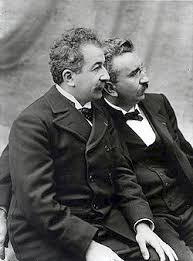The Lumiere Brothers and Homeopathy
July 03, 2010
****[ ](http://sueyounghistories.com/wp-content/uploads/2010/07/Lumiere-brothers.jpeg)Auguste
Marie Louis Nicolas****
Lumiere**{::}\**
**1862 – 1954, and Louis Jean
**Lumiere**
1864 – 1948, were among the earliest filmmakers in history,
](http://sueyounghistories.com/wp-content/uploads/2010/07/Lumiere-brothers.jpeg)Auguste
Marie Louis Nicolas****
Lumiere**{::}\**
**1862 – 1954, and Louis Jean
**Lumiere**
1864 – 1948, were among the earliest filmmakers in history,
Auguste Lumiere developed a theory called flocculation, and opened his own clinic to treat patients, despite his lack of medical qualifications, and increasingly presented his theories as an alternative to and an attack on ‘official medicine’ … ‘… Everything pointed to the idea that imbalances within the body, rather than bacteria, were the real causes of disease…’ August Lumiere contributed prominently to a collection of essays about alternative medicine published in the 1930s and early 1940s (Christopher Lawrence, George Weisz, Greater Than the Parts: Holism in Biomedicine, 1920-1950, (Oxford University Press, 1998). Pages 74-84).
Lumiere photographic plates were used by homeopaths to produce images of remedies, for example the photo plates of Tho Rad X up to the 14th dilution were printed in The North American Journal of Homeopathy Volume 59 in 1911 (Anon, The North American Journal of Homeopathy, Volume 59, (American Medical Union, 1911). Pages 815-816).
Auguste Lumiere believed that the tissue fluids, in which the vital process take place, are all colloids. The destruction of this state - flocculation (meaning the formation of solid particles in the midst of a fluid) determines illness and death (http://homeoint.org/hompath/articles/3140.html Eugene Underhill, The Homeopathic Recorder: Marius Ehny, Volume: 1953 Apr Vol LXVIII No 10).
From http://en.wikipedia.org/wiki/Flocculation Flocculation
- Particles finer than 0.1 µm (10-7m) in water remain continuously in motion due to electrostatic charge (often negative) which causes them to repel each other. Once their electrostatic charge is neutralized by the use of coagulant chemical, the finer particles start to collide and agglomerate (combine together) under the influence of Van der Waals’s forces. These larger and heavier particles are called flocs.
From http://en.wikipedia.org/wiki/Auguste_and_Louis_Lumi%C3%A8re The Lumiere brothers were born in Besançon, France, in 1862 and 1864, and moved to Lyon in 1870, where both attended La Martiniere, the largest technical school in Lyon.
Their father, **Claude Antoine Lumiere **1840 – 1911, ran a photographic firm and both brothers worked for him: Louis as a physicist and Auguste as a manager. Louis had made some improvements to the still-photograph process, the most notable being the dry-plate process, which was a major step towards moving images.
It was not until their father retired in 1892 that the brothers began to create moving pictures. They patented a number of significant processes leading up to their film camera - most notably film perforations (originally implemented by Emile Reynaud) as a means of advancing the film through the camera and projector.
The cinématographe itself was patented on 13 February 1895 and the first footage ever to be recorded using it was recorded on March 19
- This first film shows workers leaving the Lumière factory.
The Lumières held their first private screening of projected motion pictures in 1895. Their first public screening of films at which admission was charged was held on December 28, 1895, at Salon Indien du Grand Café in Paris. This history-making presentation featured ten short films, including their first film, Sortie des Usines Lumière à Lyon (Workers Leaving the Lumière Factory). Each film is 17 meters long, which, when hand cranked through a projector, runs approximately 50 seconds. The world’s first film poster, for 1895’s L’Arroseur Arrosé.
It is believed their first film was actually recorded that same year (1895)with Léon Bouly’s cinématographe device, which was patented the previous year. The cinématographe — a three-in-one device that could record, develop, and project motion pictures — was further developed by the Lumières.
The Lumières went on tour with the cinématographe in 1896 - visiting Bombay, London, New York and Buenos Aires.
The moving images had an immediate and significant influence on popular culture with L’Arrivée d’un Train en Gare de la Ciotat … and Carmaux, défournage du coke. Their actuality films, or actualités, are often cited as the first, primitive documentaries. They also made the first steps towards comedy film with the slapstick of L’Arroseur Arrosé.
The brothers stated that “the cinema is an invention without any future” and declined to sell their camera to other filmmakers such as Georges Méliès. Consequently, their role in the history of film was exceedingly brief.
They turned their attentions to colour photography and in 1903 they patented a colour photography process, the “Autochrome Lumière”, launched on the market in 1907.
Throughout much of the 20th century, the Lumière company was a major producer of photographic products in Europe, but the brand name, Lumière, disappeared from the marketplace following its merger with Ilford. The Lumières also developed other products such as a loudspeaker, “Lumière tulle gras” (a dressing to heal burns) and the homonoid forceps (a medical tool).